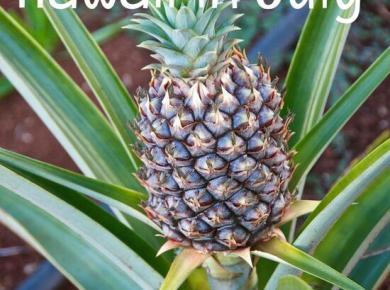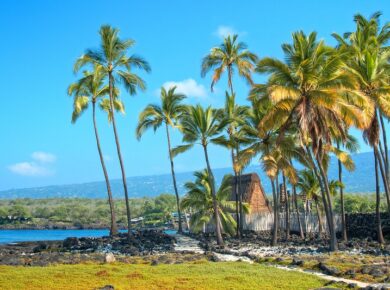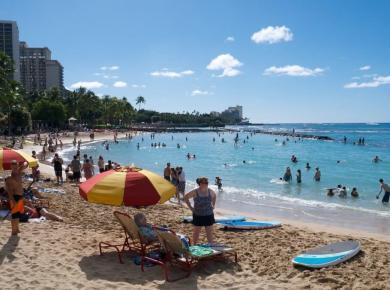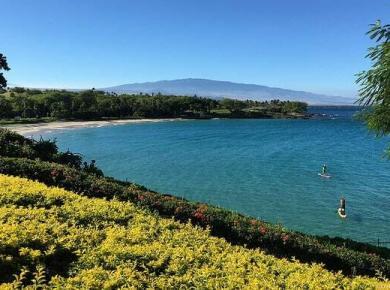You may hear the words leeward and windward to describe areas of the island, but not know what that means. In a nutshell, they essential describe how much rain an area gets and how tropical or arid an area is.
The trade winds blow from the northeast of the Hawaiian islands to the southwest. (By the way, you’ll likely hear locals refer to the trade winds, simply as “the trades”) The trade winds bring moister air. As the trade winds hit a volcanic mountain, the air cools and creates clouds. Then the clouds produce rain on the windward side. The leeward side is the drier side or the side where the trade winds pass after they hit a mountain. The windward side is the wetter side. The way I try to remember it is this way – the winds hang out and produce rain on the windward side.
As a picture is worth a thousand words, let’s look at a visual description of leeward and windward. Let’s start with leeward.
Leeward Kohala Coast of the Big Island
Now contrast the relatively dry landscape of the leeward side with very little greenery to the lush windward side.
Windward Side of the Big Island (along the 4-mile Scenic Road)
I love both the leeward and windward parts of the islands. I love that in a short drive you can see such a drastic contrast.
In general, the north and/or east sides of each Hawaiian Island tend to have the windward climate. In contrast, the south and/or west sides of the islands are leeward. The following satellite map of Hawaii’s Big Island illustrates this climate trend. The greener sides are mostly on the east side of the island, while the drier sections are on the west side.

Now let’s look at a satellite image of all the Hawaiian Islands as a whole. The following image shows the greener windward sides concentrated towards the east and north of each island. The drier, leeward, areas are concentrated on the south and west sides.

Ah, doesn’t Hawaii rock?







16 comments
I just wish Windward side could be lush and green, without all the rain. 🙁
Like you said, if you happen to find yourself on the windward side–stuck in the rain–a short drive will get you to the leeward side and usually sunshine.
While we were on the Big Island, someone told us the windward side (hilo) got about 140 inches of rain a year and the leeward got only 4 (kona). Funny thing is the first time it rained on us was in Kona…
Kona gets 60″ per year. If it got only 4″ it would be a desert…and don’t forget, mauka is very lush and green.
That’s like the time I visited Death Valley, one of the driest locations in the U.S. It rained!!!
Jim, Have you tasted the kona coffee when you were in the Big Island?
@ Andy – that would rock if you could have the lush green without all the rain, but at least you can find both areas within a brief drive.
@Jim – I think Hilo is one of the rainiest, if not THE rainiest cities in the US. The first time we went to the Big Island, we spent a few days in Volcano before heading to the Kohala Coast. In Hilo we got something like 14 inches of rain in less than 24 hours. So, we were looking forward to sunshine as we headed to the Mauna Lani. As soon as we arrived at the resort, it rained. We had to laugh as we thought about what were the odds that we would actually be on the Kohala coast during part of their 9 inches of rain they average per year. C’est la vie. 🙂
You may want to write an article explaining what “makai” and “mauka” mean and how locals use the terms when giving directions, like “mauka of Ala Moana Shopping Center”, etc. I remember I was confused when I first heard those terms being used. A pidgin primer would also be useful. I recommend the book “Pidgin to the Max”. I wouldn’t recommend trying to speak pidgin yourself, but understanding what is being said by locals is important.
Absolutely, being raised in Hawai’i and knowing pidgin, trying to talk pidgin using the great book ‘pidgin to the max’ for haoles is difficult because pronouciation is as important as the word itself when speaking it. The book is great for visitors and locals alike. I have a copy.
Fluency in pidgin determine who is haole (stranger) and local or kamaaina.
I had to chuckle… we do forget that people don’t understand what we’re talking about sometimes. 🙂 Your photos are very accurate! They look very much like a comparison between the Waianae Coast (Leeward) and the hills near Pali and Kailua (Windward) areas of Oahu. Good job!
Andy’s right too! It’s just a quick drive to move from rain forest to a much drier climate. I love both areas, for different reasons and at different times.
Chris gives very good advice. 🙂 Don’t try it until you know you’ve got it down! Which requires quite an amount of exposure.
Those dumb infomercials that try to give directions to hotels and streets in Waikiki… egads! You would think an advertiser would be more careful about such things. Odd.
@ Chris – thanks for the suggestions. So far, no one has given me directions using mauka or makai, though I have seen it used in guidebooks and heard it on the radios in Hawaii.
@Evelyn – HeHe! It’s been fun de-cyphering (as Jethro Bodine from the Beverly Hillbillies would say) Hawaiian words and phrases. 🙂 I’m still trying to learn basic pronunciations! It’s embarrassing that I can’t pronounce many Hawaiian words properly. I always apologize profusely before and after I attempt to pronounce any Hawaiian word to a resident.
Giggles! That’s fine! It’s to be expected for visitors to say the words a little strange. You can’t possibly learn them all in just one visit! You just have to keep coming back… again and again and… 😉 We base our pronunciation of other languages on that of the English language… and we often don’t do that very well either! 🙂 It’s the radio and TV people who just make you crazy because they pretend they’re doing it right while we cringe and hope nobody else is listening.
Here’s my biggest disaster to date: using “mute” when I meant to say “moot.” Ugh! It was very embarrassing, that’s why I remember it so well! Telling it to you makes it funny so I can laugh at myself now. Thanks! 🙂
Evelyn – You would probably crack up if you knew some of the crazy ways I’ve pronounced Hawaiian words. For a brief time I pronounced the word mahalo as “mah-aloha”. Sheesh! 🙂
I’ve noticed how the TV people pronounce Honolulu so perfectly. It does sound kinda funny to hear it.
That was very awesome!
I THATS COOL I TOTALLY AGREE
This would be helpful if you actually told me what windward was. Thank you but otherwise it was very helpful.
Just kidding sorry I over read what windward is!! Opppps!! My bad!